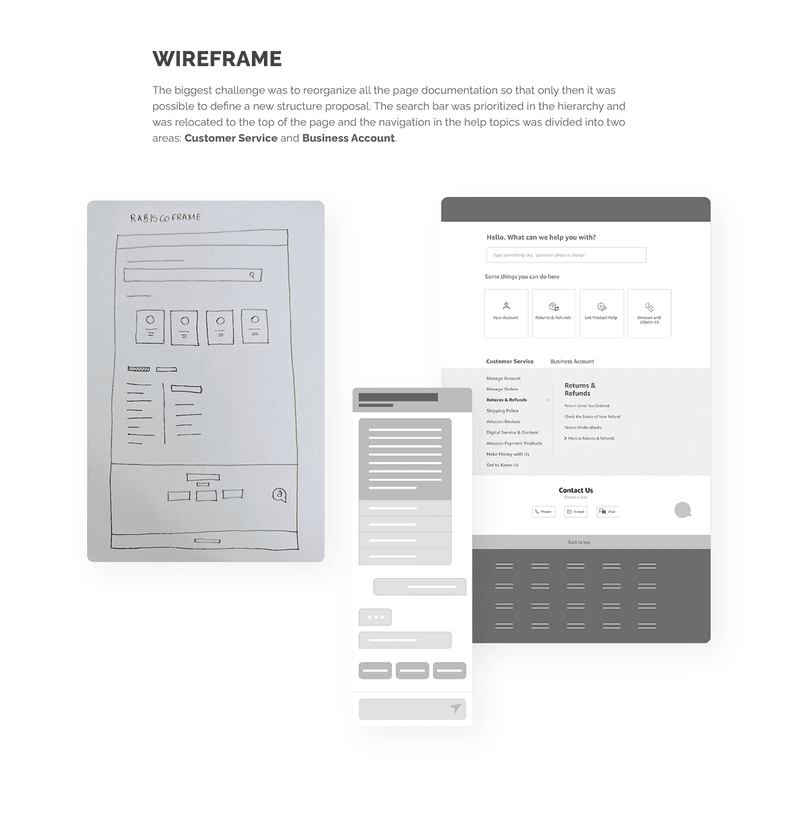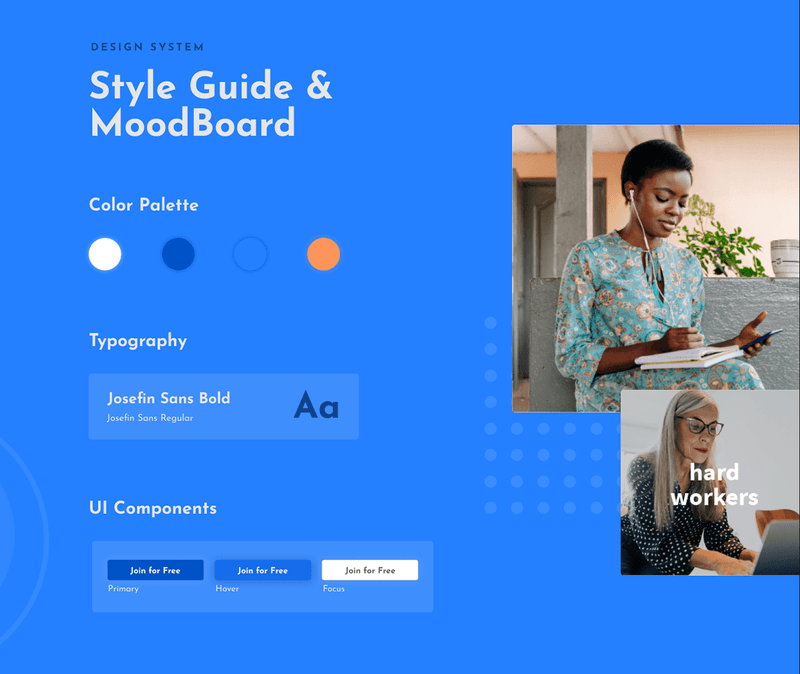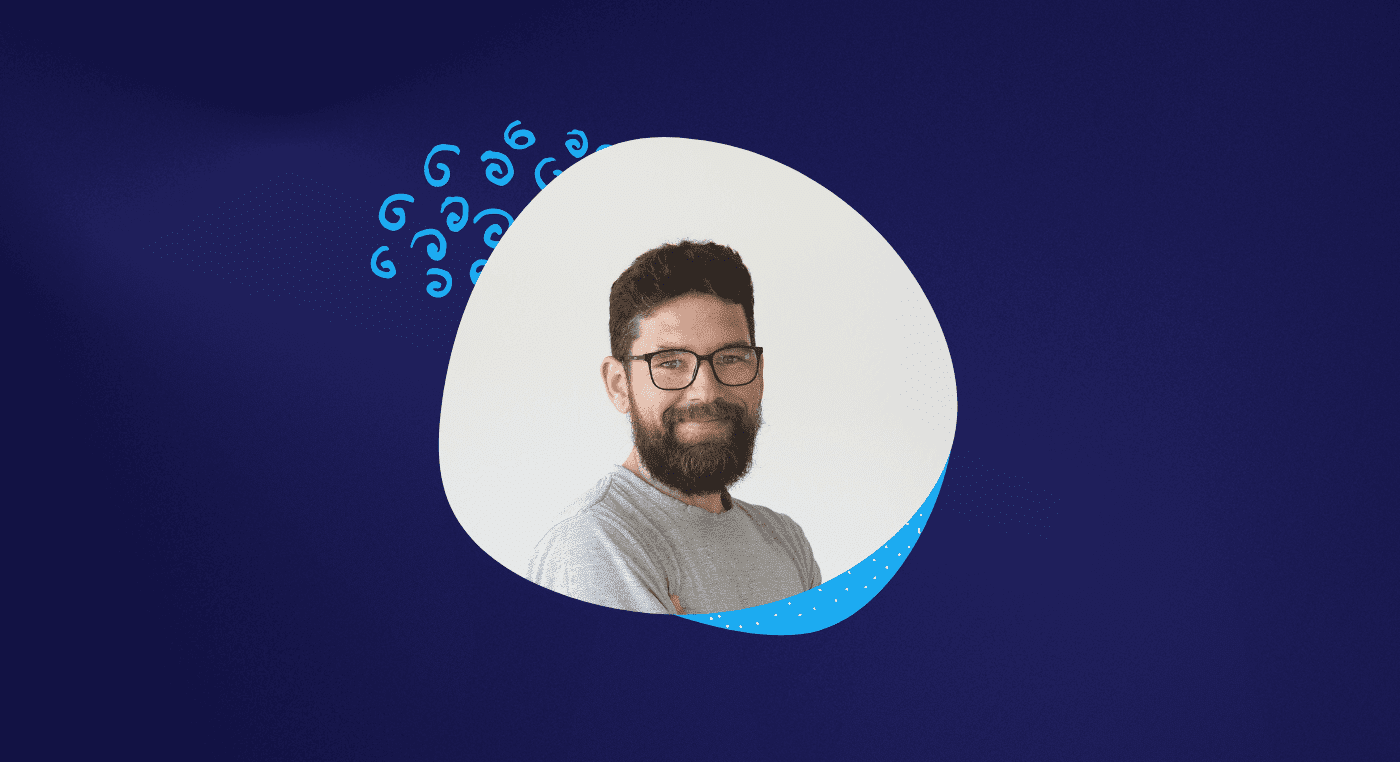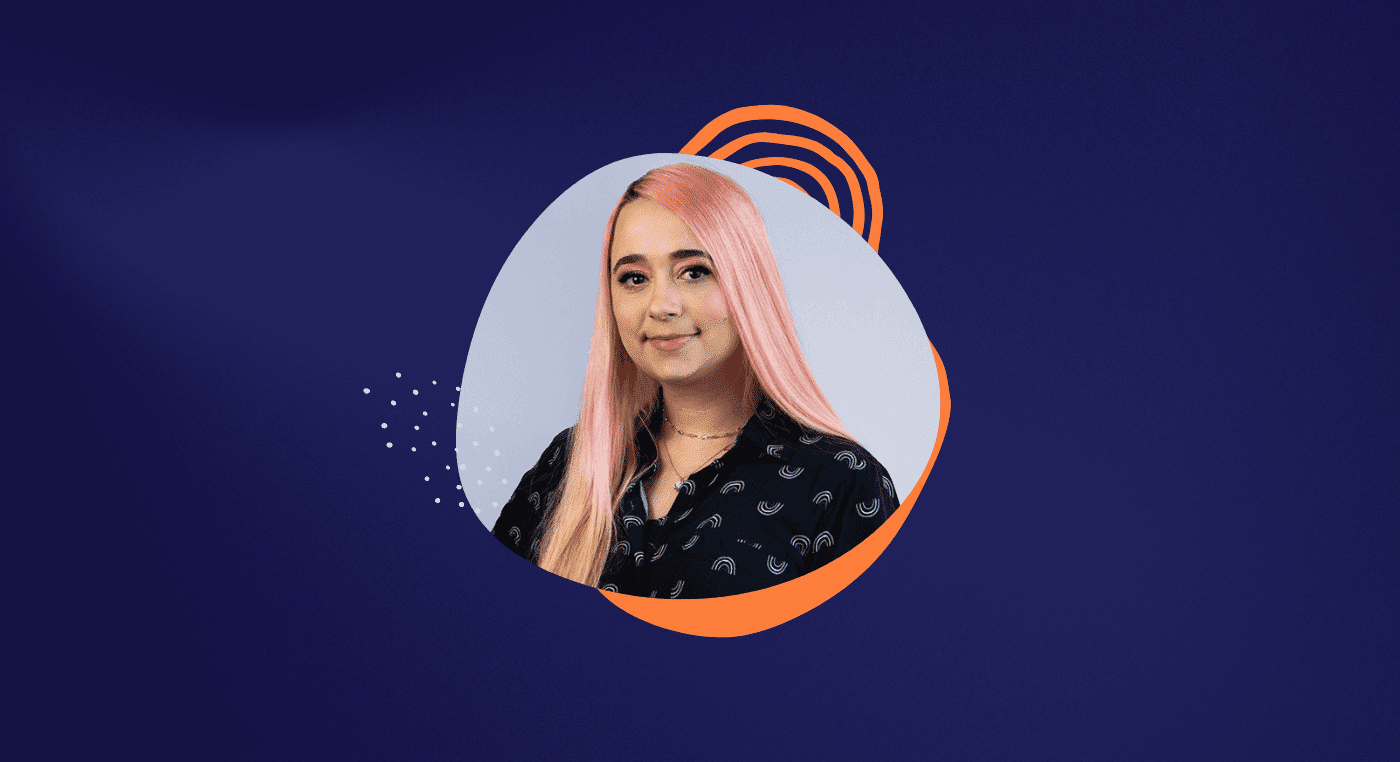Giulia Pignati is a student of the Mastering Interface Design (MID) program who successfully transitioned to UX Design with a background in Graphic Design.
In this conversation, Giulia tells us how she balanced her studies amidst motherhood and the pandemic.
Additionally, she shares how finding a study partner was crucial in exchanging experiences and staying motivated.
Giulia, please introduce yourself so we can get to know you better.
Thank you for the invitation, Felipe!
My name is Giulia, I started the MID program in 2020, and I've been working in the field for about seven months.
I graduated in Graphic Design in 2016 and worked in that field for a while. I worked for an agency, a political campaign, and even tried to transition to interior design, but I wanted more.
In 2020, I had stronger contact with UX and UI. That's when I began studying and found the MID.
Reading Tip: 11 Reasons that Make the MID an Incredible UX/Product Design Program
What caught your attention in UX Design that made you go down this path?
Initially, the visual aspect caught my attention the most because I always worked very focused on that.
I saw people posting beautiful screens on LinkedIn, and I liked it a lot and thought, "Wow, it must be cool to work with this."
But what really fascinated me was discovering the research part that underpinned everything I saw. Because everything had a reason, a meaning, a motive. It wasn't just about making something beautiful.
The more I delved into this research part, the more my interest grew. That's when I was sure this was what I wanted to do. Building something not because it will look good but because it has a foundation, a meaning, and a study behind it.
That's what really conquered me in UX Design.

Many people from Graphic Design have difficulty starting in UX Design, mainly due to the visual aspect. How was this process for you?
This happened to me too. Sometimes I focused too much on the visual, and it was difficult to let go of that mindset.
I had to clear my mind before thinking about anything visual, and that's very tough.
The research part was extremely challenging, particularly. When I started doing the projects, I saw how complicated and different it was.
So, I started doing it gradually and sending it to the mentorship [of the MID]. I asked for help and evaluation, and with every feedback I received, along with book and article recommendations, I made it a point to pause, delve into reading, and engage in thorough study.
This was because it was clear to me that the research part was my weak point.
It's great to hear about your dedication! Would you say that this change in mindset helped you enter the market? Or was it something else?
Definitely, it was the change in mindset, and the MID helped me a lot along the way. Because it's very easy to think about changing, but that doesn't happen overnight.
You will face challenges, and you will make mistakes.
My first job opportunity came to me through LinkedIn. I posted a MID project on Behance and shared it on my platform profile. Through this post, some recruiters came to talk to me, and from there, the opportunity to do a challenge arose.
The challenge asked for a solution to a problem, and I faced it as if it were a MID project. I decided to work with everything I was learning and understanding.
Only after I left the company did the recruiter come to tell me that mine was the best challenge project she had ever received. She said she had never seen anything so well-structured, with such deep research in that way.
I thought about how this was normal in the MID, something that everyone does. I was surprised to have this feedback because, to me, that was the minimum expected.
Reading Tip: 7 Mistakes to Avoid In Your UX Design Portfolio
You started the MID program at the end of 2020, in the midst of the pandemic. Given this chaotic scenario, how did you maintain your focus and mental health?
Well, it was complicated because a day before the lockdown in my city, I had my baby.
So, at the beginning of the pandemic, I was at home with a newborn.
But I think deep down, that's what helped me keep my sanity. Life inside the house was normal, with a child, you have work all the time.
This situation helped me stay focused. Dedication to the course was vital. I had already committed myself, and I knew it couldn't be something I did on a whim. I really wanted to invest in my UX Design career.
The whole situation was difficult. We were with the baby, without anyone's help, locked up at home. But at night, I would put him in his crib, and the only thing I could think of was to continue with the course, advance with a project, and things like that.
Being isolated also helped me not worry about other things and focus on my personal projects. I might have been more distracted if I had constant invitations to go out or events to attend.
So, the pandemic was terrible for everyone, but in the end, it helped me in this sense.

Did you organize your life in any specific way to create a study-related habit?
Actually, no. It was very difficult because, with a small baby, I didn't have a set schedule for anything.
My husband worked all day, even from home, and I couldn't control my schedule.
I studied whenever I could. When you're very busy, you can be more productive than when you have lots of free time.
So because I don't have much free time, I wanted to use the little spare time I had to be productive in some way.
The only thing I did was always keep up with my readings. So, I always read the complementary readings and the books you recommended in the MID.
When I realized that I had some points to improve, whether in a project, a stage, or because I wasn't able to keep up with the level of others in the course, I looked for a book on the topic.
When I felt weak in research, I read Just Enough Research, which you always talk about.
From the beginning, I had already read Don't Make Me Think and Lean UX.
Whenever I had difficulty with a topic, I looked for a book you had already recommended to improve myself.
At one point, I was reading about one book per week. I read quickly because I wanted to avoid leaving the projects idle for too long and also because I wanted to apply that knowledge.
And whenever I needed to, I consulted the books and my notes again. We don't remember everything we read, so it's important to review.
Reading opened my mind to many different subjects. Despite reading many articles, I felt the books were much more in-depth.
This was the only practice I followed during my UX Design study process. When I felt difficulty with something, I looked for a book.
In the MID program, we encourage community development by suggesting that you study in pairs. How was this process, and how can you extract the most from it for your studies?
It's interesting that you mention this because nowadays, I advise everyone to do this.
At the beginning of the course, I didn't have a study partner. I didn't have anyone who lived close to me in my city. In the beginning, many people were looking for someone nearby, but I couldn't find anyone, so I was without a partner for a while.
Moreover, I thought it wouldn't be good because, as I said, I didn't have a defined routine. I did things when I could, in my time. So, I thought my dynamic could end up hindering my partner.
But the truth is, that's nonsense. Today, I say that people at different levels can help each other, and it works very well.
After a while alone, I started exchanging ideas with Amanda, who was a friend of mine who was already in the course and already had a partner. She put me in a group with other girls, and we helped each other a lot there.
We shared projects, asked questions, helped each other in moments of despair and anxiety, and so on.
I got very close to Amanda; we were always talking and exchanging ideas. We even tried to make a mini book club. We exchanged feedback and encouraged each other in many ways.
When one of us was more distant, we would pull the other back. And this partnership and encouragement made all the difference to me.
I can say for sure that she helped me get my current job. She helped me not only with technical challenges but also with the presentations I needed to make. She was always willing to help me.
I've always been very shy, and she helped me overcome that by making me present a project at Aela. All of this opened many doors for me, and I'll be forever grateful to her for that.
That's why whenever someone asks me about it, I say it's essential to find a partner or a colleague to talk to and help each other.

You mentioned anxiety. How did you help each other control anxiety and stay calm?
Most of the time, we shared our insecurities about projects, progress in our studies, and so on.
But when one of us shared these thoughts with the group, the others would encourage and support them by complimenting their projects, giving advice, and other things.
It was great because we lifted each other up and always tried to help.
At the end of the day, it was always a matter of insecurity.
For example, Amanda and I had to wait for opportunities to come to us. If we had waited to feel secure before applying for a job, it might have taken much longer to happen.
Reading Tip: Impostor Syndrome: Are We Really Incapable as We Think?
How was the process of getting your first UX Design job?
It didn't happen the way I expected. In fact, it was much faster than I thought!
After posting my project on LinkedIn, a recruiter from a company in Sao Paulo and a recruiter from London contacted me. However, in the case of the London company, they needed someone with more experience in UX Design, someone more senior.
In the case of the Sao Paulo recruiter, she asked me if I was available to take on a challenge, and I agreed. She sent me a PDF with a briefing, and I had five days to develop a solution to help improve the productivity of people who work remotely.
From there, I did a complete study, almost like an Aela project. In the end, I even developed a high-fidelity prototype. This was an advantage that I didn't need to deliver, but I had done all the studies and research to do it and ended up developing it.
I made a navigable prototype, submitted the challenge, and on the same day, the recruiter contacted me, asking if I was available for an interview.
I did the interview, told her a little bit about myself, explained that I had no experience, and took a quick English test. They needed someone fluent in English to work on an international project.
On the same day, she sent me an offer, and a month later, I started working. I stayed with them for five months on the same international client.

For those who are listening, it may seem like a short time, but it was quite intense, including traveling and many changes.
True. It was my first experience as a Product Designer and with an international client. I had never had this opportunity before.
On my first day, I participated in a meeting as a listener, but people ended up talking to me, and I was quite nervous. That's where you put your English skills to the test.
But everything went well, and shortly after, I was already presenting things to the client, receiving feedback, and participating much more actively. It was very good.
There was a workshop week where we visited them in the United States. We followed the daily routine of a client using the platform that we were redesigning. It was an enriching experience. In five months, you learn a lot because it's intense, as you said.
Why did you stop working with them?
Actually, I received another offer from an American startup, where I am currently working.
In fact, I have had the opportunity to work with one of the MID mentors, and it is very good, I'm learning a lot from him.
In my last job, I missed having someone with more experience. I was the lead designer on a huge and extremely complex project. Of course, I did what had to be done, but often insecurity struck and it was difficult not to have someone to ask and share doubts with.
It was a very big responsibility and of course, I learned a lot and always did my best. But I missed that support.
In this new opportunity, besides being more financially interesting, there is also this issue of being together with a very experienced person in UX Design and it's amazing.
Reading Tip: 5 Reasons to Look for a UX Design Mentor
You mentioned that for your first opportunity; recruiters came to talk to you from a project post on Behance via LinkedIn. What was the reason for your project to attract so many eyes?
I can't say exactly what caught the attention of each recruiter. In addition to the two recruiters I mentioned, another person came to talk to me. A Brazilian who had an American company and who told me something interesting.
The project I shared was about Spotify, and he said that this project was related to the product he was developing, and that's why he was interested in contacting me.
So, in this case, this person saw a similarity between the project and the business. But it's hard to say what catches other people's attention.
I think the first impression is basically the visual of the project. But when you open it and come across research, interviews with users, and the whole process behind it, that makes a big difference.
It's very different to put the process step by step instead of just putting the final project screen. So, having the story of how you developed and the reasons why you made the decisions for that project makes all the difference.
Although there is an appealing visual that catches attention, I think the description of the process is what influences the most. But there is also what I mentioned, there is the similarity of the project with the product they are developing.

What would you do differently if you were starting the course today from scratch? Is something different in your routine?
I don't know if I would change anything in my routine because that depends a lot on each person's situation.
If I started today, I would do my projects in stages. For each stage, I would send it to the mentorship and try to be more confident in presenting the projects in live feedback because they are very enriching.
I would also look for a partner earlier to exchange ideas, someone who was committed like me to sharing things and helping each other. All of this makes a big difference.
Do you have any tips you would like to leave for those interested in studying UX Design?
Don't wait to be ready to start. You will never be ready to start. Start as soon as possible.
Don't waste time.








